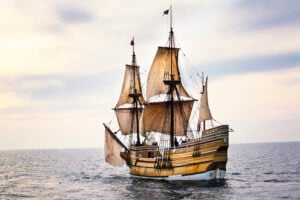I’ve always had a fascination with tall ships and antique sailing vessels. I like to think my interest is ingrained, coming genetically from my Norwegian seafaring ancestors. And I don’t mean Vikings, though it’s fun to think about those. I mean my oceanographer grandfather, Navy Lieutenant Commander great-grandfather, and sailor-turned-Coast Guard captain great-great-grandfather.
I’ve been lucky enough to indulge in my sailing fantasies a few times. Once I spent three days on a tall ship sailing off the coast of Los Angeles, on-board the Exy Johnson with the Los Angeles Maritime Institute. I’ve done evening and overnight tall ship cruises on the Hudson River on the Mystic Whaler. I even spent a couple of hours painting the Mayflower II back in 2008 as part of a community service experience for high schoolers.
I can’t really compare the ships I’ve been on to the Mayflower, or even her replica the Mayflower II. While my trips were on ships not dissimilar in size to Mayflower – the Exy Johnson and Mystic Whaler both have sparred length of 110 feet,[1] while Mayflower II’s overall length is 106 feet[2] – I had significantly fewer passengers with whom to contend. There were 102 passengers aboard the Mayflower when it made its transatlantic crossing;[3] my experiences were with no more than thirty or so people on board.
Modern-day tall ships, even those built in the traditional style of eighteenth- and nineteenth-century sailing vessels, forsake authenticity for modern conveniences and living standards. While the Pilgrims lived on the “tween deck” with a ceiling height of no more than 5½ feet,[4] I lounged in cabins with ceilings eight or nine feet tall. While the Pilgrims used chamber pots to relieve themselves, we had modern heads (tiny though they were) with flush toilets and showers. We also had plenty of food, twenty-first century GPS equipment and charts, and electricity.
Modern-day tall ships, even those built in the traditional style of eighteenth- and nineteenth-century sailing vessels, forsake authenticity for modern conveniences and living standards.
Back in 1957, thirty-three individuals (and one cat) did experience something like what the Pilgrims experienced on their journey from England to Massachusetts. The Mayflower II was somewhat more modern, with a wheel in place of a tiller, generator, electricity, radio system, inflatable life rafts, and a full galley.[5] Despite this, the 1957 crew often complained of her “shortcomings” and “imperfections,” unaccustomed to the quirks of a three-masted square-rigged seventeenth-century ship.[6]
In preparation for the 2020 festivities, Mayflower II has been undergoing a complete restoration at Mystic Seaport in Connecticut, part of a multi-year project.[7] She’ll be in Boston in May 2020, one of many events commemorating the four hundredth anniversary of the landing of the original Mayflower at Plymouth.[8] Though I don’t have any Mayflower ancestors, I was enthralled by the Mayflower II the first time I saw her, thrilled to spend a few hours working as part of a volunteer project, and am constantly impressed by the legacy of Mayflower and Mayflower II.
Notes
[1] Hudson River Sloop Clearwater’s Volunteer Handbook for the Schooner Mystic Whaler, 2, and “Our Ships,” Los Angeles Maritime Institute Topsail Youth Program.
[2] “Mayflower FAQs,” Plimoth Plantation.
[3] Nathaniel Philbrick, Mayflower: A Story of Courage, Community, and War (New York: Viking, 2006), 3.
[4] Ibid.
[5] Maitland A. Edey, “A Modern Pilgrimage,” Life, 17 June 1957, 20.
[6] Ibid., 28, 35.
[7] “Mayflower II Returns,” Mystic Seaport Museum.
Share this:

About Hallie Kirchner
Hallie Kirchner is a genealogist and part of the team that performs research-for-hire for patrons. In addition to working with patrons to answer their family history questions, Hallie also helps with the Ask-A-Genealogist chat service and has worked on a variety of educational programs during her time at American Ancestors. Her areas of expertise include 19th-century America, Germany, and immigration.View all posts by Hallie Kirchner →
